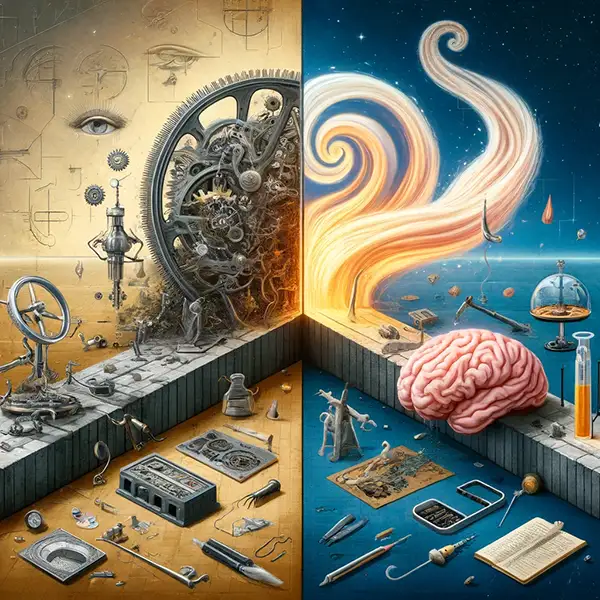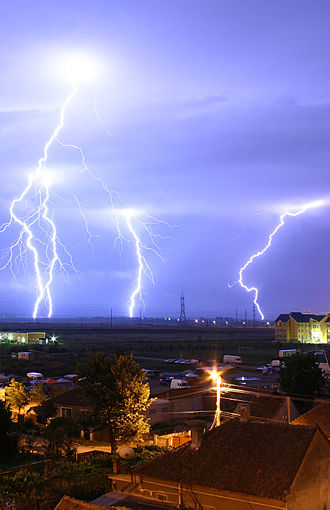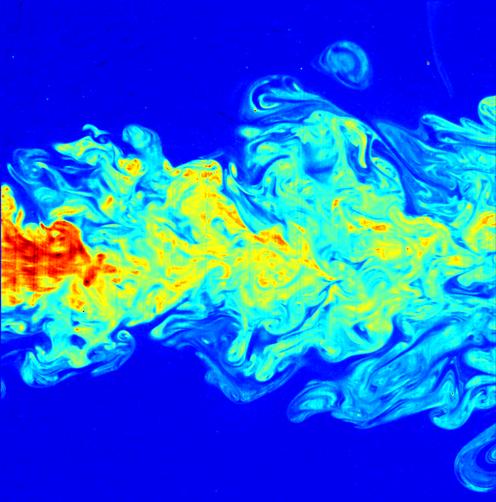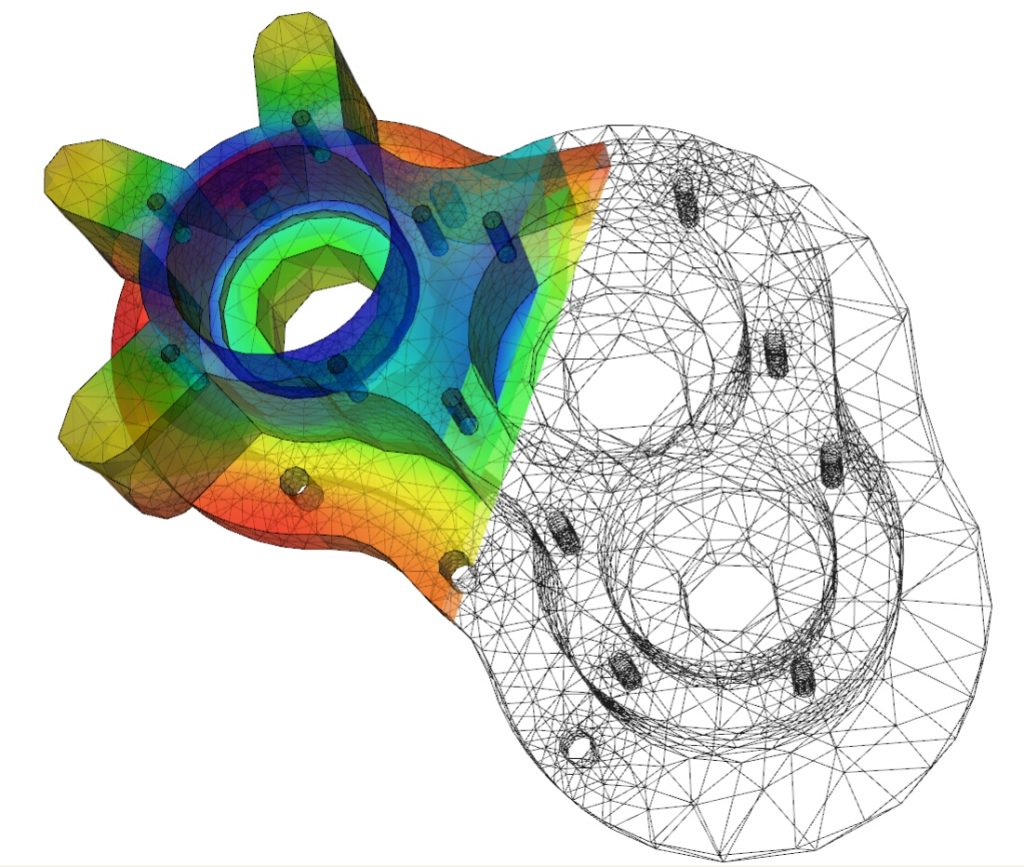5.2 Epistemic Emergence in Scientific Description

Reductionism
Scientific enquiry is often said to be broadly reductionist in approach. Making descriptions at various levels of enquiry is part of what is known as reductionism. The human body, for example, can be explained at the level of molecules and cells, as interconnected organ systems, and as a functioning whole with complex behaviours. We can also extend the description of humans to describe communities of interacting individuals, for example. Complex entities, such as living things or ecosystems, cannot be easily understood so the reductionist examines different parts of the entity or system individually in order to try and understand how they each function or, of equal importance, how they also malfunction.
In popular culture we normally think of a complex system as being more the ‘sum of its parts’. Humans, for example, cannot be comprehensively described by merely making a list of molecules and their interactions. This is in part due to the limits on reductive enquiries that we make. We don’t (yet) know, for example, how approximately 20,000 human genes can function together to develop and sustain an individual human for our very brief existences. However even if we knew who all of these molecular components interacted it is highly likely that we could not predict the existence of cells and how they functioned, from that knowledge alone. Nor could we predict and explain the development of the fetus, the procreation of the next generation of individuals, and death. Biology is almost unimaginably more complex than the trivially simple ‘Standard Model‘ of particle physics! (I am of course not claiming that rigorously understanding the Standard Model is easy or even possible for most of us.)
While we wish to understand the whole, it seems that we can only turn to creating explanations of the parts at different levels of complexity if we are to gain any in depth understanding. Explaining human cardiovascular disease might require a knowledge of certain fatty molecules but it is incomplete without understanding the role of advertising of junk food on commercial TV. We need to understand biochemistry as well as human culture that emerges from the way we individuals organise our society. As a consequence different targets for enquiry are approached with differents methods and expertise. We do this in the hope that when we understand the components of the system we can then begin to deduce how the complexity of form and function of a system emerges. However this is in practice where we fail. Insead we tell a series of what we hope are logically interlinked stories
Emergence
Emergence is concerned with the nature of complex systems or entities. Emergentist thinking acknowledges the idea that complex systems or entities, such as the human body, if they are to be comprehensively understood, first need to be described at various levels of complexity. However it it also accepts that properties of the system as a whole will ’emerge’ from the inherent complexity of many parts. We feeble humans have great difficulty in describing the components very complex systems and so we have little chance of understanding their apparently ’emergent’ behaviour
In very general terms emergentism is the counterpart to reductionism. Both are needed in producing explanations of complex systems. We need to understand the parts to know how the ‘whole’ functions as a system. However we still need to look holistically at a (conceptually) complete system to understand how it functions.
By describing a system property as emergent, we are saying that there are properties of systems and sub-systems that cannot apply to their component parts. The age of a whole person, for example, cannot be applied to individual blood cells which die and are replaced many times during a lifetime. The whole person has many properties not shared by individual cells, organs or limbs.
Notice that we are not invoking some mystical complexity or supernatural properties of complex systems by considering emergence. We are merely engaged in the analysis of complexity. If we are to efficiently describe complex systems as a whole, we need to invoke descriptors that do not apply to the component parts. Epistemic emergence deals with properties of complex systems as a meta-level explanatory strategy.
There are some who dispute the validity of epistemic emergence as an instructive concept. In order to consider whether the concept of emergence is useful or not, simply to ask yourself, do we need various levels of explanation to understand the world? Then reflect on the simple slogan that tries to capture the idea of epistemic emergence; ‘the whole appears to us as more than the sum of its parts when it possesses properties not present in the components’.
Emergent Descriptors
If we consider emergence from a linguistic perspective, we can immediately see the need for system descriptors that coexist with descriptors of the components. Indeed there is nothing to be gained in explanatory terms by avoiding the uses of system descriptors when appropriate. For example, it does not make sense to say ‘that collection of several hundred billion cells with an XX chromosomal karyotype died’ when we mean ‘the woman died’. At a level of emergent description above the cell we would not say, ‘that example (or instantiation) of skin, bones, muscles, nervous system, liver, kidney, lungs, reproductive organs, vascular system, gastrointestinal tract and associated parasites climbed the tree’ when we mean, ‘the cat climbed the tree’. At an even higher level of complexity, we could simply say ‘the national language of Austria is German’, rather than declare that ‘most of the people within a region of Europe delineated by {a very long list of geographical coordinates} use the following words and rules of grammar followed by {a list of 1 million German words and rules of syntax}.
One very important characteristic of emergent descriptors is that we do not need to know every characteristic and component of a system and their interactions to apply the system-level description. I do not need to know every word of the English language (including archaic meanings) to use the term ‘English’.
Perhaps, more importantly, the concept of emergent descriptors offers us insight into the most efficient ways to formulate useful descriptive statements about the world. It might be accurate to list all the words we can think of that have the tag of ‘this is a German word’, but it is not useful to do so, when for the purposes of a particular explanation, we need only apply the system-level descriptor ‘German’.
When it comes to communications, we are necessarily committed to the use of system-level descriptors. Life is literally too short and no computational system so powerful that we can do without them.
Emergent Properties
The concept of a component and system-level emergent descriptors is uncontroversial for it is part of our everyday experience. Is there something more fundamental about the epistemic concept of emergence than linguistic descriptors?
In the examples given above animals and languages were being described merely as the summation of the components parts? Can we, however, attribute properties (or if you prefer, descriptors) to the complex system level, which do not apply to its components?
When we examine the properties of a complex system there will be some that are easy to describe or calculate from the properties of the parts. If we were to weigh the parts of a car then assemble them together the mass would be the same. The rational process of summing the masses together would leave us with a quantity that was identical to the sum of the parts. There would be nothing emergent about the mass of the assembled car. (Notice also that here the mass measurements are said to be commensurable as the parts and the whole car are assessed by the same conceptual action of weighing and the property is expressed in the same conceptual units of measurement; kilogrammes). Mass is the most obvious property of a complex system that is not emergent.
Can we say that an object is still a car when it is reduced to its component parts? The obvious answer is no. It is a special collection (or set) of objects that can be used to generate a particular model of car. The purpose of the assembly is to create a composite object in which the parts interact, some in dynamical ways. The act of assembly confers on the complete vehicle the transportation properties of a car. Emergent properties of the car arises from the construction process and the related information content and energy input required for the assembly. Interaction of the parts and the process which gives rise to the interaction then confer system level, or emergent, properties on the whole.
What might those emergent or system-level transportation properties of a car be? As we have already seen, the mass of the car cannot meaningfully be described as emergent. The emergent properties might include passenger capacity, top speed, acceleration from a standing start, braking efficiency in dry and wet conditions, fuel consumption, fuel range, load capacity, reliability and a host of other features. Taken together these descriptors would explain what all of the bits of a car do as a collective when combined into a functioning whole. Interestingly we might claim to have a good descriptive representation of the car merely by examining the whole vehicle and ignoring the properties of sub-systems and parts. This is by definition a feature of all systems with emergent properties.
Nevertheless, can we claim to really understand what a car actually is until we have understood what parts it is composed of and how each of their functions are interconnected? In science, this approach is referred to as reductionism. By the process of reductionism or reductive investigation, we hope to be in a position to eventually synthesise conceptually a functioning whole from the parts. One advantage of understanding the properties of the parts is that we can attempt to make predictions about the properties of the whole. In the case of a car if we had a knowledge of the mass, the tyre characteristics, the top speed, and the force that can be applied by the braking system we could make predictions and so design a safe enough car without too many iterations in the design process.
However there is a more radical view, held by some, that can be described as ‘radical emergence’, in which the underlying laws, of physics, for example, cannot be used to describe the functioning of biological evolution for example. ( see this interview with Stuart Kauffman)
Gaps in Explanation and Difficulties of Prediction
Where there are emergent properties, are we committed to an ‘explanatory gap’ between different levels of explanation within a hierarchy of complexity? In other words, if we have a sufficiently detailed description of each component and sufficient computational power at our disposal could this allow us to describe or predict the global properties of the whole system? It seems not.
It is very tempting to suggest that it is merely ignorance or a lack of understanding of the detailed properties of the components of a system that prevents us from integrating our levels of understanding to describe the properties of the whole. It would seem that we need not in principle be committed to such a gap since the properties of the complex system emerge from the coming together of the parts. The optimist might conjecture that if one day our knowledge of the parts became comprehensive enough we might reach a stage where we have all of the information required to predict the properties at a system level.
Nevertheless, in practice, explanatory gaps between levels of explanation often exist for sufficiently large enough or complex enough systems. The question then arises as to whether or not it is the degree of complexity per se rather than the need to employ emergent descriptors which produce gaps in our understanding.
It seems that the existence of emergent properties does not, as a matter of logical necessity, create explanatory gaps. However when we deal with an enormously complex entity like the human nervous system, with its many cell types and sensors, and its gigantic number of interconnections, many have wondered whether we could ever model the seemingly emergent property of human consciousness. In this case, for example, part of the problem might not be one of emergence per se but the sheer difficulty of dealing with enormous complexity. It might also be caused in part by the very tricky and perhaps insoluble problem of trying to objectify subjective experience.
When we consider the sociability of humans, or the tendency of sardines to form enormous shoals, or the spread of disease with populations of animals, it seems highly unlikely we could ever integrate our descriptions in a sufficiently complex way to describe these emergent properties from the properties of single cells for example.

Termite Mound (viewable from space)
Photo by: Hansjoerg Morandell
CC BY 2.0, https://commons.wikimedia.org/w/index.php?curid=680062
Given a very detailed study of an individual termite, for example, we would not predict the building of enormous 3-4 m mounds by a community of these animals who cooperate while maintaining distinct functional roles for individuals.
Clearly, there exist sufficiently complex systems that possess emergent properties, which we could not predict only from our present knowledge of the parts. One cannot easily determine if that is a transient state of knowledge related to our current ignorance and lack of computational power or a more permanent and fundamental condition. There are of course chaotic systems with non-linear properties that can be extremely difficult to predict but which we might not classify as emergent. For both of those reasons, we should be hesitant when ascribing unpredictability to composite systems of simple entities merely because they have emergent properties. Nevertheless, we can be confident about the existence of emergent system-level properties and the need for emergent descriptors and be sure in our knowledge that many complex and emergent systems are unpredictable.
Sometimes the gaps in our understanding concern the emergent properties, rather than of the individual components and very often a mixture of both. In addition, we can then add to that picture the intrinsic unpredictability of some system characteristics. Consider the emergent nature of lightning storms.

Complex and unpredictable paths of lightning discharges
Image source: by
https://en.wikipedia.org/wiki/Lightning#/media/File:Lightning_over_Oradea_Romania_3.jpg
The movement of small particles in the air when combined together causes massive electrical charge separations. The discharge then takes place in a largely unpredictable fashion producing, cloud-to-ground, cloud-to-cloud and intra-cloud discharges with many kinds of discharge patterns. Just about the only thing, we can say of a discharge is that if the clouds are near enough to the ground, there might be cloud-ground discharges. However, a surprising property of lightning discharges, is that some have been accidentally discovered, to produce brief flashes of gamma rays, which are detectable by orbiting satellites.
Cascading Levels of Biological Complexity
Complexity within SIngle Cells
It seems that we cannot produce a mechanistic or functional explanation of the world by starting with fundamental particles and build, at least conceptually, the human brain. Instead, we have distinct levels of explanation about the behaviour of particles, of atoms, small molecules, intracellular and extracellular macromolecules that are involved in cell and tissue functions including self-replication. All of the above are organised into macromolecular complexes, sub-cellular organelles, and functional micro-domains within the cell.
The fully functioning cells are extremely complex since they also possess interacting internal metabolic and signalling pathways. They must have mechanisms for surface and internal transport of small molecules and active translocation mechanisms for the cell to function. In order for life to reproduce all of the above must be coordinated into the cell cycle so that replication can occur. The complexity of the single-cell can, of course, be hijacked by a large number of infectious and parasitic organisms and viruses leading to yet a vast range of emergent states.
The single-celled organism represents the most conceptually fantastic leap between mere molecules and emergent life. Of course, this did not happen within a philosophy semester but was perhaps as short as 300 million years in length. As a result, in living things, we might have the most complex state of matter within the observable universe. (Of course, that was only made possible by nucleosynthesis of heavy atoms by stellar nuclear fusion during several cycles of star formation and supernovae explosions.)
The Complexity of Multicellular Organisms
Between 3.5 billion years ago and the Cambrian Explosion of 500 million years ago there was yet another large leap in complexity which gave rise to evolved multi-cellular eukaryotic organisms. Most multicellular organisms have specialised or differentiated cell types produced by differential gene expression. These differentiated cells then evolved to form distinct tissue and organs that have very different emergent functions, yet are very tightly interdependent.
Within multi-cellular organisms neighbouring cells interact in very complex and diverse ways that give rise to the different tissue and organ functions including those of the more diffusely located immune system, which has its very own signalling mechanisms. At a higher level of biological organisation, organs have a very complex set of interactions with one another including, physical structural links and physiological interconnections, that might be metabolic, hormonal or neuronal. The concept of a hormone that is involved in physiological signalling and operates at the organ level can also be understood as one that is occurring between non-neighbouring cells since that is the functioning unit of life. Indeed the concept of a hormone is meaningless in the absence of the idea of cells with synthetic pathways to make a hormone molecule, other cells with receptors that are acted on by the hormone and even distinct organs which can communicate with one another in a variety of ways.
It should be abundantly clear from this dazzlingly hierarchical and complex organisation that the whole body and the parts of the whole, has a super-abundance of emergent properties. Others have pointed out that even at much simpler levels within the composite whole this way of thinking applies. The idea of a protein enzyme only applies if there is a molecule on which it can act to perform some kind of chemical change. The explanatory concept of enzyme function can itself be considered as emergent.
Complexity of the Biosphere
Although the fundamental unit of life is the emergent replicating cell and organism, to fully understand emergence in biological systems, we need to consider the entire biosphere using ecological descriptors that do not apply to individual living things. We might consider, for example, host and parasite relationships, fused symbionts, populations organisms, the size, density and distributions of those populations, prey and predator and mixed communities of organisms. We need to understand biodiversity and interdependence of organisms through and a fantastically complex web of interactions between the plants, fungi, bacteria, viruses, invertebrates and vertebrates that involve dynamically changing nutrient cycles and energy flows.
The explanatory concept of the biosphere (and all that entails) is probably the highest level of emergence that we can presently contemplate based on present-day observations in any type of science. If you doubt this then bear in mind there may be tens of millions of species, and each one will have it own emergent properties. If you are still sceptical, consider that organisms also modify their own environment and that, as we now know, can even impact on a global scale. Human-induced climate change is an obvious but small example. The accumulation of oxygen in the earth’s atmosphere caused by the activity of living organisms is a much more spectacular possibility.
If you accept the argument that our description of life on this planet needs a multiplicity of descriptors operating at a staggering number of different levels of complexity, then you have accepted the need for the idea of epistemic emergence. The concept of emergence is of course enhanced when we acknowledge the existence of evolution in the widest possible sense.


The South Manhattan skyline seen from Liberty Park New Jersey at sunset. Consider the various levels of emergence that can be posited to explain human culture, its diversity and evolution
Photo by Steve 2016
Evolution and Malfunction
If in addition at least some of the components of the system are capable of spontaneously changing (or evolving) in their structure or properties, our predictive abilities are even more restricted. Given the existence of early unicellular life, it would not be possible to predict the evolution of massive dinosaurs. The future is not determined although it is constrained by the present in very significant ways.
Clearly, we should also view the unpredictable consequences of malfunctions, as further evidence of emergent behaviour. In medicine, cancer can be seen as an emergent fault, i.e. one that would not be predictable without direct observation of cancer. The information stored in the control system (DNA) might only undergo a minute change and produce exceedingly complex behaviours.
Downward Causation
Some philosophers argue that emergent systems should exhibit downward causation in which the whole system can affect the parts. This characteristic definitely seems to apply in biological systems. Consider how the whole human can influence body parts and cells:
- Bodybuilding exercises can make muscles cells larger
- Eating behaviours can cause fat cells to accumulate lipid
- The manufacture and fuelling of rockets and space travel can cause loss of bone mass.
- Taking hormone pills can reduce bone mass loss in older women
- Tobacco growing and smoking can cause lung cancer
- Running can produce osteoarthritis of the joints
- Manufacture and abuse of alcoholic drinks can produce drunkenness, injuries, paradoxical disinhibition, sexual promiscuity, pregnancy, cirrhosis of the liver, cancer and premature death
- Chemical synthesis within the laboratory and abuse of psychoactive drugs can induce psychosis
- Junk food manufacturing and marketing can lead to obesity glucose intolerance and related dysfunctions.
We can see from that above list that emergent properties at the individual and societal levels can have cascading downward effects on parts and functions of the human body. There is no doubting the possibility of downward causation in dynamic systems where the idea of causation can be meaningfully applied. It does not seem however that downward causation is a more general or necessary property of systems in which we can use the notion of emergent properties.
Computation and Emergence
Is a system epistemically emergent if we cannot ourselves calculate its state given the properties of its component parts but can do so instead by numerical simulation on a computer? In other words, do some complex entities seem emergent to us just because we have not applied enough calculation or applied sophisticated enough mathematical logic? A reasonable but simplistic answer is no.
Even to rigorously solve how turbulence forms in the exhaust gases emerging from the back of a jet engine presently takes months of computing by some of our fastest machines (although approximate short-cuts can be used). Knowing this, we then have to admit that the complexity of the world is such that the unaided human brain cannot produce explanations of complex entities. What we are dealing with is a system that exhibits very complex non-linear behaviour. Complexity and emergent properties are not the same things. Complexity might involve emergent properties, but they are not a prerequisite. In the light of the previous discussions ask yourself; does that mean the exhaust gas flow demonstrates emergence?

“Flow visualization of a turbulent jet, made by laser-induced fluorescence.
The jet exhibits a wide range of length scales, an important characteristic of turbulent flows.”
Image and Legend Source: https://en.wikipedia.org/wiki/Turbulence
Take an even more extreme example, could you use computers and quantum mechanics to predict the existence and behaviour of your neighbour’s cat? A more refined version of that question might be could you ever, even after the development of very complex computers, running much more sophisticated algorithms as yet undreamed of, with much more computational power than we have available today produce such predictions? The answer has to be no. Of course, part of the reason for this is to do with the contingencies of history. The existence of cats came about by the occurrence of a gigantically large number of random events that occurred during abiogenesis (the development of the first living things) and the subsequent evolutionary development and extinction of many species. We simply cannot predict the future states of systems that exhibit enormous complexity and non-equilibrium dynamics.
Ironically, in order to determine what it is that we can and cannot explain with the assistance of computers, we need a new level of yet another form of analysis: computer science. We would like to know what classes of problems are computable and which are not. Even although computer science is very much in its infancy, it is already very clear that some truly complex problems will not be numerically solvable even by much faster quantum computers. Even computable problems that require a very modest size of input but an exponentially defined number of computing steps are in practice not computable. If future quantum computers were a million time faster than they are today, there appear to be conceptually simple problems that are not numerically solvable even if future machines could run for longer than the age of the universe. (The ‘brute force’ decryption of payment encryption keys used in online shopping transactions is a simple example of a computationally difficult task.)
If the computational abilities of computers were increased spectacularly, it seems likely there are features of complex systems that we would still find were not numerically predictable except in a very approximate fashion. Part of the problem is that often we do not, and perhaps cannot, know about the existence of the parameters that need to be used in calculations that model emergent characteristics in very complex entities, like living things.
Computational complexity does not mean that we should label all complexity as emergent. We should only do so when we require additional explanatory concepts for different levels within the system.
One intriguing use of computation, with regard to emergence, is the generation of visualisations and prediction using the techniques of finite element analysis and computational flow dynamics. Finite element analysis, to quote the software developer Autodesk, is a:
“computerized method for predicting how a product reacts to real-world forces, vibration, heat, fluid flow, and other physical effects. Finite element analysis shows whether a product will break, wear out, or work the way it was designed. It is called analysis, but in the product development process, it is used to predict what is going to happen when the product is used”.
EA works by breaking down a real object into a large number (thousands to hundreds of thousands) of finite elements, such as little cubes. Mathematical equations help predict the behaviour of each element. A computer then adds up all the individual behaviors to predict the behavior of the actual object.”

Finite Element Analysis using the Heat Equation and a mesh to describe a manufactured component. Please note that “the mesh is quite coarse intentionally for presentation purposes”. In other words, critically important calculations would use a finer mesh size. Image source: https://hu.m.wikipedia.org/wiki/F%C3%A1jl%3AElmer-pump-heatequation.png?wprov=sfla1
In this case of manufactured steel components, there are ‘real’ emergent properties arising from the chemical composition, grain structure and overall geometry of the object. There is no need however to analyse the overall mechanical performance of a large metal object at the level of the individual grains. The methods mentioned here use a virtual or simulated substructure to compute numeric descriptions of these objects based, ironically, on the emergent material properties to locally solve the equations.
In the case above the simulation uses emergenet characteritiscs of the material as follows:
Name = "Steel (alloy - generic)"
Poisson's ratio = 0285
Heat Expansion Coefficient = 1 2.0E-6
Youngs modulus = 20 0.0e9
Heat Conductivity = 3 7.2
Sound speed = 510 0.0
Heat Capacity = 97 6.0
Mesh Poisson Ratio = 0285
Density = 785 0.0
Poisson ratio = 0287
Youngs modulus = 20 0.0e9
(source: https://hu.m.wikipedia.org/wiki/F%C3%A1jl%3AElmer-pump-heatequation.png?wprov=sfla1)
So in addition to actual emergence, we have of virtual emergence as a form of applied scientific prediction.
How Does this Relate to Pragmatism?
If we are to make apparently accurate statements about complex systems, it is evident from the above that we must accept the need for different levels of description within hierarchies of complexity. To understand that complexity, we need to study the behaviour and structure of the whole and various subsystem levels, where these can be identified. We, therefore, require a reductionist approach to understanding the component parts. However, we must be aware that it is complexity per se which puts limitations on our predictive capacities. Emergent properties are an additional challenge.
An Informative Anecdote
When machines that we build develop a malfunction, the resultant behaviour of the system might come as a surprise. You can probably think of many such effects. One that amuses me is a personal anecdote about my wife’s car. She complained about the fact that the car was making a banging noise and reported this to the garage. Rather intriguingly, in the end, they changed a light bulb.
The garage technician took it for a drive. He heard nothing unusual. His boss then took it out on the road again and noticed that the vehicle was pulling to one side. This defect, he worked out, was due to the anti-skid braking system coming on and off on one side of the car. It seems that this might be the source of the noise. Why had the braking system malfunctioned? No one in the garage could understand the problem at first. It was then noted that an indicator lamp bulb was not working. When the bulb was changed the brakes worked fine again. The light bulb was replaced, and the noise stopped. No one in the garage had ever encountered such a problem and were at a loss to understand the reason. Automotive design engineers might be able to explain this unusual occurrence but could they have predicted what happened? I consider this to be a very intriguing example of human-engendered emergent and complex behaviour within a system.
Videos
There is a very interesting series of interviews on emergence at:
https://www.closertotruth.com/topics/cosmos/deep-laws-nature
The first below looks at emergence in a wider context than discussed here.
The Hierarchy of Life as emergent properties
The longer video below is from a meeting in Chicago and has contributions from several speakers including a Nobel prize winner.
Art Inspired by Emergence
Max Cooper – Order from Chaos – Official Video by Maxime Causeret
Max Cooper – Order from Chaos – Official Video by Maxime Causeret from Max Cooper on Vimeo.
Online Text Sources On Emergence
Emergent properties
http://plato.stanford.edu/entries/properties-emergent/
Emergence at IEP
http://www.iep.utm.edu/emergenc/
Emergence Wikipedia
http://en.wikipedia.org/wiki/Emergence
Self Organisation
http://en.wikipedia.org/wiki/Self-organization
Emergent Organisation
http://en.wikipedia.org/wiki/Emergent_organization
Conway’s Game of Life
http://en.wikipedia.org/wiki/Conway%27s_Game_of_Life
Life-like Cellular Automaton
http://en.wikipedia.org/wiki/Life-like_cellular_automaton
Books
Emergence: Contemporary Readings in Philosophy and Science (Bradford Books) (2008)
Edited by
Version 2.4, 2024
< Previous | Index | Next available >